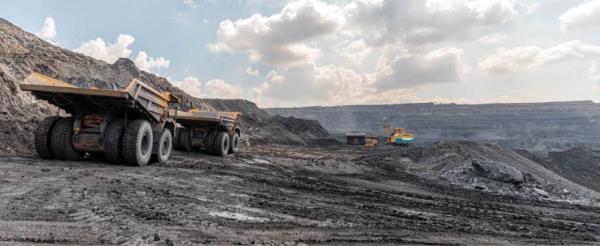21 December 2023

Mining – one of the darkest and most dangerous places of employment in the world – is facing a renaissance in connectivity, adopting new technologies to enhance safety and efficiency…
Mining has been a mainstay of Africa’s economy for eons thanks to the continent’s plentiful mineral resources and their significant contribution to exports, revenue, and gross domestic product (GDP). Before the COVID-19 pandemic, minerals and fossil fuels accounted for more than 33% of exports from nearly 66% of African nations.
Overcoming challenges
Mines are notoriously dangerous and dirty environments in which to work, requiring more ruggedised communications networks than most urban or consumer environments.
“As consumers, we accept dialling back if we lose a mobile connection. However, that cannot happen in a mine if the end device is on a person needing help or autonomous equipment, reporting a dangerous malfunction,” highlights Louis Lambert, chief revenue officer, 6harmonics. “Mining IoT, IIoT, and HSE depend on guaranteed service at all times and everywhere.”
Delivering reliable communications to remote African mines is challenging amidst limited infrastructure, scarce and unstable power, geographical barriers, access to spectrum, extreme weather, and security issues.
“Harsh, hostile environments like mining, whether it is deep mine or open cast, requires good quality, high performance communications equipment for longevity and on-site safety,” says Linda Clark, managing director, Mobile Mark Europe.
“Transport infrastructure can be inconsistent, with poor travelling conditions making logistics arduous and complicated,” notes Nimrod Kapon, CEO, OASIS Networks.
“Political instability can also hamper the ease in which ground segments are setup. Shipping equipment can be challenging and there are many anecdotes of deliveries being held up at the border.”
Additionally, there’s a lack of technical expertise, high costs, complex regulations, and the need to address vast distances in some of the harshest conditions in the most economical manner, reports Burchell Trevor, head of the Intracom Telecom RSA office: “addressing the challenges in open mines demands innovative solutions specifically engineered for the extreme conditions encountered in these environments.”
Despite the challenges, mining operators stand to gain from a suite of communication applications tailored to their precise needs.
“Voice communication ensures coordination and safety, while data transmission enables real-time equipment monitoring. Fleet management applications optimize routes and maintenance, enhancing efficiency,” says Trevor.
Lambert reports that fleet management is a significant contributor to the data payload on today’s mining network. “It is among the highest-priority traffic due to its high importance in operational safety and efficiency,” he adds. “Fleet management also incorporates multiple video sensors and streaming video, fed to AI to manage safety, equipment functions, maintenance, and location.”
“The modern mine has come to rely heavily on automation, from self-driving loaders and trucks to automated drills and AI-driven video surveillance,” says Robert Bell, executive director, World Teleport Association. “Those systems, in turn, rely on connectivity across the mining operation, to regional offices, headquarters locations and the worldwide web. The good news for mining companies and their investments is that connectivity has become less expensive, more powerful, and more flexible over the past few years than anyone could have anticipated.”
Terrestrial vs orbital
Since most mines are beyond the reach of fibre, terrestrial wireless has been the solution of choice for decades.
“Terrestrial wireless is, in most cases, the best choice as it is less expensive and usually more straightforward to implement. However, it still requires a tower and, in some instances, repeater towers that must be erected and powered,” says Lambert.
While WiFi has been the staple of onsite connectivity for years, private LTE is rapidly emerging as a preferred technology.
“Mines are using private LTE for group communications, push-to-talk radios, and push-to-video, which can speed collaboration and problem solving. More sophisticated applications include high-accuracy positioning of their automated vehicles to prevent accidents, control of drone networks and video analytics,” says Bell.
“LTE is the new darling in mining, more so than WiFi and even 5G,” asserts Lambert. “LTE delivers mobility, nomadicity, traffic prioritization, and a massive ecosystem.
The challenge is with access to spectrum on the surface. For underground deployments, spectrum is not an issue as it is unregulated in a private underground environment. LTE offers reliable and predictable connectivity to fixed and mobile assets, and, with the evolution of autonomous use cases, becomes the best choice for the distribution network as it can also deliver access layer connectivity.”
While fibre may offer higher performance than WiFi and LTE, and is expanding significantly across the continent, satellite remains the core option for connectivity from the mine to the world, because most mining operations are located far from urban areas.
“GEO satellites are powerful and offer highly reliable service, but the distance from satellites to the ground introduces latency. For most applications, this is not a problem – but enterprise resource planning systems and cloud services from Microsoft Office to mining applications such as EarthCache and Lightship are highly interactive and operate poorly over high latency connections,” says Bell. “Massive investment over a decade has created satellite constellations operating in medium Earth orbit (MEO) and low Earth orbit (LEO). At these lower altitudes, latency ceases to be a barrier, and the new generations of spacecraft being launched are making available massive amounts of new bandwidth at much lower prices.”
Lambert agrees that satellite is becoming essential in areas where fibre or terrestrial wireless are not achievable at reasonable prices: “LEO pricing and coverage are becoming more attractive, but with that comes volume and over-subscription. The solution is so prevalent in some areas that performance is starting to degrade.”
Whatever the solution, Kapon believes that it’s important to pick a solution with hot-backup options.
“If budget will not allow this, at least to provide spares on site,” says Kapon. “In some countries, such as Ethiopia and Eritrea, it is impossible to source equipment locally for regulatory reasons and Return Merchandise Authorisation process can take a long time. It is much more efficient to plan a solution with spares from day one!”
Safety first
As with all heavy industries, connectivity has become crucial to the safe, secure, and efficient operation of the modern mine.
“Mining has long been one of the most dangerous jobs in the world,” says Bell. “With competition for qualified talent at an all-time high, automating work site surveillance with video analytics can produce sizable improvements in worker safety.”
Indeed, safety and security are paramount and a fast-growing segment of the total communication payload. “Air, water, temperature, toxic gas, and other mission-critical monitoring are no longer just small amounts of data moving in the network, but also include live video streams analysed by AI at the area level or the mine level,” explains Lambert. “The AI results are correlated at the mine and corporate levels to compare operations across multiple assets.”
Keeping employees safe is paramount to successful mining operations, helping to retain the best staff and reduce the increased costs related with staff churn.
“Unlike supervisors, cameras and data processing systems never sleep or get distracted, and they can play a key role in making sure employees comply with rules designed to protect them. The health of people living near the mine is equally important to progressive operators. The same surveillance and analytic capabilities enable mines to monitor their environmental impact and take pre-emptive action to prevent harm,” explains Bell.
Mining ‘costs a fortune every minute’
Modern communications in mining can help improve profitability as well as safety and efficiency.
Kapon describes his experience of a communications failure: “I’ve visited a mine myself that had to stop its production for almost one full week because they could not communicate and plan the production, schedule the loading at the port and movement of trucks. As the sites are usually remote, dispatching someone might take several, expensive days.”
“Communications have one of the highest impacts on the mining sector’s profitability, efficiency, and safety,” asserts Lambert. “Mining costs a fortune every minute. Any lost minute cost a fortune, so having access to information in real-time from all connected people and things allow humans and machines to make faster decisions and save lost production minutes, hours, shifts, and possibly even lost lives.”
“Effective communication significantly boosts mining sector profitability and efficiency by enabling real-time coordination, improving safety, optimizing resource use, reducing downtime, streamlining supply chains, ensuring compliance, and fostering innovation,” agrees Trevor.
The mine is a constantly changing environment, which can be challenging to operate in. Reliable, assured real-time communications enable increased efficiency, instant learning, decisions for situations, and accident avoidance.
“As sensors on mining equipment and systems collect massive amounts of data, it creates an opportunity for sophisticated analysis that reveals bottlenecks and cost-inefficiencies in operations,” says Bell. “Analytics can also generate predictive maintenance schedules based on operating data, so that equipment can be quickly taken offline and serviced before a major breakdown can bring operations to a halt.”
“To many mining executives, communication infrastructure pays for itself immediately the first few times they avoid shutting down or slowing down production,” adds Lambert.
Connecting the future
As the mining sector in Africa continues to modernise, digitalise, and take advantage of all high-speed connectivity has to offer, communications service providers (CSPs) have a crucial role to play.
“These wireless networks enable real-time data collection, IoT device integration, and predictive maintenance, enhancing safety and operational efficiency,” says Trevor.
“The future has started, and it is not only about autonomous operations, but also about electrification and a swarm of lighter vehicles,” adds Lambert. “More process automation and functions help keep miners away from hazardous areas. For a crucial role, SME miners will be able to oversee multiple operations simultaneously.”
After decades of slow progress, recent years have seen significant advancements in the uptake of Mining 4.0 technologies, and it’s important that the entire ecosystem comes on board to support these developments; from governments to authorities, from CSPs to vendors.
“For Africa to benefit fully from its mineral abundance, policy leaders need to understand the requirements of modern mining companies for productivity, connectivity, and process automation,” says Bell.
“At first, MNOs did not fully grasp the mission-critical nature of mining and brought forward consumer-grade 4G solutions - but they are learning and investing. 5G SA is a better platform for the CSP to build mining offerings; however, MNOs and smaller CSPs will have to work harder at simplifying the 5G SA solution for the mining operators,” says Lambert. “For our part, we are developing an edge computing technology and orchestration control system to simplify the deployment of rugged IP67 edge computer and communication devices that integrate 4G, 5G, WiFi, LoRA, GNSS, Bluetooth Beacon, and accelerometers to truly simplify the simple deployment of complex technology enabling reliable mixed communications and computing where it matters – at the edge of the network.”






